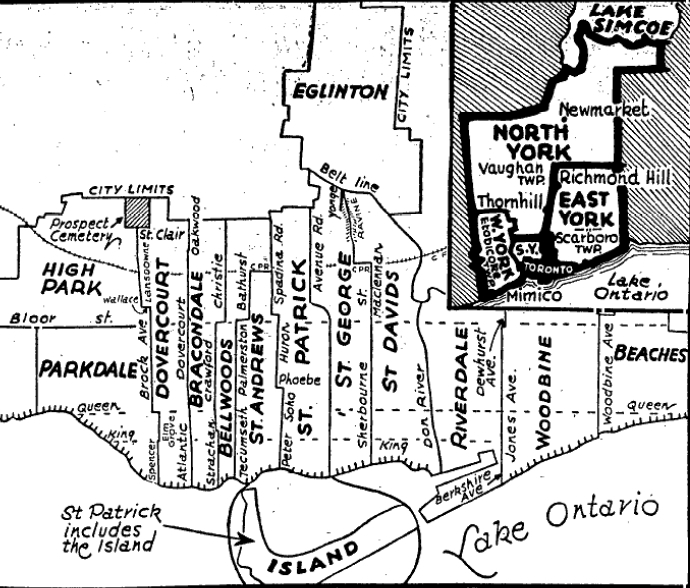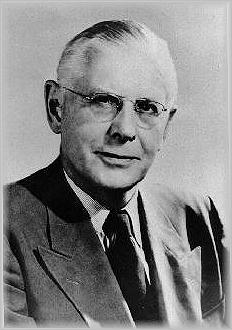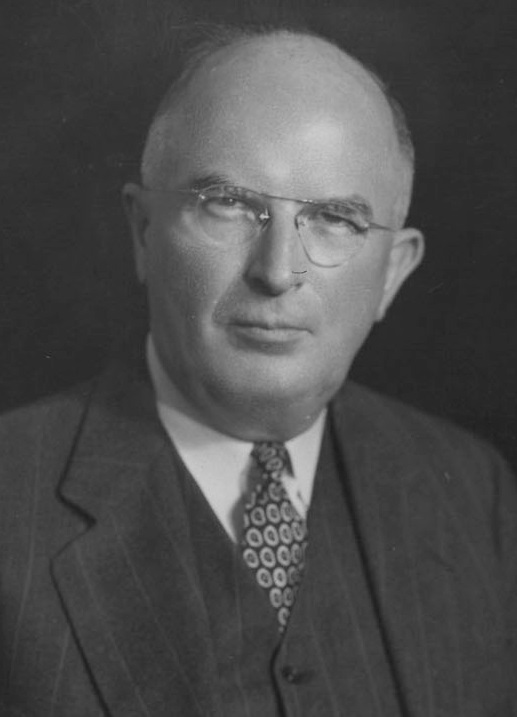|
St. Patrick (electoral District)
St. Patrick was a provincial electoral district in Ontario, Canada, that was established in 1926 out of the district of Toronto Northeast. It lasted until 1967 when it was merged with St. Andrew to form St. Andrew—St. Patrick. St. Patrick riding took its name from the former "St. Patrick's ward" of the City of Toronto. Boundaries It was created after a major riding redistribution in 1926. Its boundaries consisted of Spadina Avenue on the west from Toronto Harbour Toronto Harbour or Toronto Bay is a bay on the north shore of Lake Ontario, in Toronto, Ontario, Canada. It is a natural harbour, protected from Lake Ontario waves by the Toronto Islands. Today, the harbour is used primarily for recreational b ... north to the city limits just north of St. Clair Avenue. On the east the boundary followed Simcoe Street north from the harbour to Queen Street West. After a short jog east to University Avenue it followed that street north through Queen's Park Crescent and then conti ... [...More Info...] [...Related Items...] OR: [Wikipedia] [Google] [Baidu] |
Electoral District (Canada)
An electoral district in Canada is a geographical constituency upon which Canada's representative democracy is based. It is officially known in Canadian French as a ''circonscription'' but frequently called a ''comté'' (county). In English it is also colloquially and more commonly known as a Riding (division), riding or constituency. Each federal electoral district returns one Member of Parliament (Canada), Member of Parliament (MP) to the House of Commons of Canada; each Provinces and territories of Canada, provincial or territorial electoral district returns one representative—called, depending on the province or territory, Member of the Legislative Assembly (MLA), National Assembly of Quebec, Member of the National Assembly (MNA), Member of Provincial Parliament (Ontario), Member of Provincial Parliament (MPP) or Newfoundland and Labrador House of Assembly, Member of the House of Assembly (MHA)—to the provincial or territorial legislature. Since 2015, there have been 338 ... [...More Info...] [...Related Items...] OR: [Wikipedia] [Google] [Baidu] |
1937 Ontario General Election
The 1937 Ontario general election was held on October 6, 1937, to elect the 90 Members of the 20th Legislative Assembly of Ontario ("MLAs"). It was the 20th general election held in the Province of Ontario. The Ontario Liberal Party, led by Mitchell Hepburn, was re-elected for a second term in government, with a slightly reduced majority in the Legislature. The Ontario Conservative Party, led by William Earl Rowe, was able to win six additional seats, and continued to form the official opposition. Meanwhile, the fledgling democratic socialist Co-operative Commonwealth Federation (CCF) ran 37 candidates out of a possible 90, led by party president John Mitchell running in Waterloo South, who also campaigned throughout the province on the party's behalf. The election, however, resulted in a modest decline in popular vote and the loss of the party's sole MLA, Sam Lawrence in Hamilton East. Incumbent MLA Farquhar Oliver was the last remaining United Farmers of Ontario MLA and ran a ... [...More Info...] [...Related Items...] OR: [Wikipedia] [Google] [Baidu] |
New Democratic Party Of Ontario
The Ontario New Democratic Party (french: link=no, Nouveau Parti démocratique de l'Ontario; abbr. ONDP or NDP) is a social-democratic political party in Ontario, Canada. The party currently forms the Official Opposition in Ontario following the 2018 general election. It is a provincial section of the federal New Democratic Party. It was formed in October 1961 from the Co-operative Commonwealth Federation (Ontario Section) (Ontario CCF) and the Ontario Federation of Labour (OFL). For many years, the Ontario NDP was the most successful provincial NDP branch outside the national party's western heartland. It had its first breakthrough under its first leader, Donald C. MacDonald in the 1967 provincial election, when the party elected 20 Members of Provincial Parliament (MPPs) to the Ontario Legislative Assembly. After the 1970 leadership convention, Stephen Lewis became leader, and guided the party to Official Opposition status in 1975, the first time since the Ontario CCF d ... [...More Info...] [...Related Items...] OR: [Wikipedia] [Google] [Baidu] |
Mark MacGuigan
Mark Rudolph MacGuigan, (February 17, 1931 – January 12, 1998) was a Canadian academic and politician. Born in Charlottetown, Prince Edward Island, the son of Mark Rudolph MacGuigan and Agnes Violet Trainor, he was educated at Saint Dunstan's University (B.A.), the University of Toronto (M.A., Ph.D. (Philosophy)), Osgoode Hall Law School (LL.B.), and Columbia University (LL.M., J.S.D.) University of Prince Edward Island. Retrieved 7 July 2012. He was a professor at Osgoode and the University of Toronto and was dean of law at the . MacGuigan was elected as a |
1963 Ontario General Election
The 1963 Ontario general election was held on September 25, 1963, to elect the 108 members of the 27th Legislative Assembly of Ontario (Members of Provincial Parliament, or "MPPs") of the Province of Ontario. The Ontario Progressive Conservative Party, led by John Robarts, who had replaced Leslie Frost as PC leader and premier in 1961, won a seventh consecutive term in office, and maintained its majority in the legislature, increasing its caucus from the 71 members elected in the previous election to 77 members in an enlarged legislature. The Ontario Liberal Party, led by John Wintermeyer, increased its caucus from 22 to 24 members, although Wintermeyer lost his seat of Waterloo North. He resigned as party leader but the Liberals continued in their role of official opposition. Robert Gibson of Kenora was re-elected as a Liberal-Labour MPP sitting with the Liberal caucus. The social democratic Co-operative Commonwealth Federation was formally dissolved and succeeded by th ... [...More Info...] [...Related Items...] OR: [Wikipedia] [Google] [Baidu] |
1959 Ontario General Election
The 1959 Ontario general election was held on June 11, 1959, to elect the 98 members of the 26th Legislative Assembly of Ontario (Members of Provincial Parliament, or "MPPs") of the Province of Ontario. The Ontario Progressive Conservative Party, led by Leslie Frost, won a sixth consecutive term in office, and maintained its majority in the legislature, although it lost 12 of the 83 seats it had won in the previous election. The Ontario Liberal Party, led by John Wintermeyer, increased its caucus from 11 to 22 members, and continued in the role of official opposition. Liberal-Labour MPP Albert Wren was re-elected and continued to sit with the Liberal caucus. Wren died in 1961 and was succeeded in a by-election by Robert Gibson. The social democratic Co-operative Commonwealth Federation (CCF), led by Donald C. MacDonald, won two additional seats, for a total of five. Results , - ! colspan=2 rowspan=2 , Political party ! rowspan=2 , Party leader ! colspan=5 , MPPs ! ... [...More Info...] [...Related Items...] OR: [Wikipedia] [Google] [Baidu] |
1955 Ontario General Election
The 1955 Ontario general election was held on June 9, 1955, to elect the 98 members of the 25th Legislative Assembly of Ontario (Members of Provincial Parliament, or "MPPs") of the Province of Ontario. The Ontario Progressive Conservative Party, led by Leslie Frost, won a fifth consecutive term in office, increasing its caucus in the legislature from 79 in the previous election to 83. The Ontario Liberal Party, again led by Farquhar Oliver, won three additional seats in the enlarged legislature, increasing its caucus from 8 to 11, and continuing in the role of official opposition. Liberal-Labour MPP Albert Wren was re-elected and continued to sit with the Liberal caucus. The social democratic Co-operative Commonwealth Federation (CCF), led by Donald C. MacDonald, won one additional seat, for a total of three. The Labor-Progressive Party (which was the Communist Party) lost its last remaining seat with the defeat of J.B. Salsberg. One "PC Independent" was elected. Ex ... [...More Info...] [...Related Items...] OR: [Wikipedia] [Google] [Baidu] |
1951 Ontario General Election
The 1951 Ontario general election was held on November 22, 1951, to elect the 90 members of the 24th Legislative Assembly of Ontario (Members of Provincial Parliament, or "MPPs") of the Province of Ontario. The Ontario Progressive Conservative Party, led by Leslie Frost, won a fourth consecutive term in office, increasing its caucus in the legislature from 53 in the previous election to 79—a solid majority. The Ontario Liberal Party, led by Walter Thomson, lost six seats, but regained the role of official opposition because of the collapse of the CCF vote. Albert Wren was elected as a Liberal-Labour candidate and sat with the Liberal caucus. The social democratic Co-operative Commonwealth Federation (CCF), led by Ted Jolliffe, lost all but two of its previous 21 seats with Jolliffe himself being defeated in the riding of York South. One seat was won by J.B. Salsberg of the Labor-Progressive Party (which was the Communist Party of Ontario). LPP leader A.A. MacLeod lost his d ... [...More Info...] [...Related Items...] OR: [Wikipedia] [Google] [Baidu] |
Lionel Conacher
Lionel Pretoria Conacher, MP (; May 24, 1900 – May 26, 1954), nicknamed "The Big Train", was a Canadian athlete and politician. Voted the country's top athlete of the first half of the 20th century, he won championships in numerous sports. His first passion was football; he was a member of the 1921 Grey Cup champion Toronto Argonauts. He was a member of the Toronto Maple Leafs baseball team that won the International League championship in 1926. In hockey, he won a Memorial Cup in 1920, and the Stanley Cup twice: with the Chicago Black Hawks in 1934 and the Montreal Maroons in 1935. Additionally, he won wrestling, boxing and lacrosse championships during his playing career. He is one of three players, including Joe Miller and Carl Voss, to have their names engraved on both the Grey Cup and Stanley Cup. Conacher retired as an athlete in 1937 to enter politics. He won election to the Legislative Assembly of Ontario in 1937, and in 1949 won a seat in the House of Commons. Man ... [...More Info...] [...Related Items...] OR: [Wikipedia] [Google] [Baidu] |
1948 Ontario General Election
The 1948 Ontario general election was held on June 7, 1948, to elect the 90 members of the 23rd Legislative Assembly of Ontario (Members of Provincial Parliament, or "MPPs") of the Province of Ontario. The Ontario Progressive Conservative Party, led by George Drew, won a third consecutive term in office, winning a solid majority of seats in the legislature—53, down from 66 in the previous election. Despite winning a majority, Drew lost his own seat to temperance crusader Bill Temple. Instead of seeking a seat in a by-election, Drew left provincial politics to run for, and win, the leadership of the federal Progressive Conservative Party. Drew was replaced as Ontario PC leader and premier by Thomas Kennedy on an interim basis, and then by Leslie Frost. The Ontario Liberal Party, led by Farquhar Oliver, increased its caucus from 11 to 14, but lost the role of official opposition. Only one of the three Liberal-Labour MPPs sitting with the Liberal caucus, James Newman, was ... [...More Info...] [...Related Items...] OR: [Wikipedia] [Google] [Baidu] |
Sam Walsh (politician)
Samuel Walsh (August 31, 1916 – March 18, 2008), was leader of the Communist Party of Quebec for 28 years, from 1962 to 1990, and was a leader in the Communist Party of Canada and Labor-Progressive Party since the 1940s. Early life and education Walsh was born in Montreal as Saul Jerome Wolofsky. His father was Hirsch Wolofsky, publisher of the '' Keneder Adler'' (Canadian Eagle), Canada's first Yiddish newspaper. At the age of 17, Wolofsky took part in a student strike against an increase in high school tuition fees. He became a Communist with the encouragement of his older brother, Moishe, a union organizer. His father asked them to change their names to avoid embarrassing the family and so Moishe became Bill Walsh and Saul became Sam Walsh. Walsh enrolled in biology at McGill University and obtained a Bachelor of Science degree in 1938. He moved to Toronto. Career Walsh ran for public office at least 30 times in his career, and was elected twice as a school trustee in T ... [...More Info...] [...Related Items...] OR: [Wikipedia] [Google] [Baidu] |
1945 Ontario General Election
The 1945 Ontario general election was held on June 4, 1945, to elect the 90 members of the 22nd Legislative Assembly of Ontario (Members of Provincial Parliament, or "MPPs") of the Province of Ontario. The Ontario Progressive Conservative Party, led by George Drew, won a second consecutive term in office, winning a solid majority of seats in the legislature—66, up from 38 in the previous election. The Ontario Liberal Party, led by former premier Mitchell Hepburn, was returned to the role of official opposition with 11 seats, plus 3 Liberal-Labour seats that it won, out of 6 contested, in coalition with the Labor-Progressive Party (which was, in fact, the Communist Party), in an effort to marginalize the CCF. The three new Liberal-Labour MPPs were James Newman of Rainy River, Joseph Meinzinger of Waterloo North and Alexander Parent of Essex North. The social democratic Co-operative Commonwealth Federation (CCF), led by Ted Jolliffe, was reduced from 34 seats to only ... [...More Info...] [...Related Items...] OR: [Wikipedia] [Google] [Baidu] |






